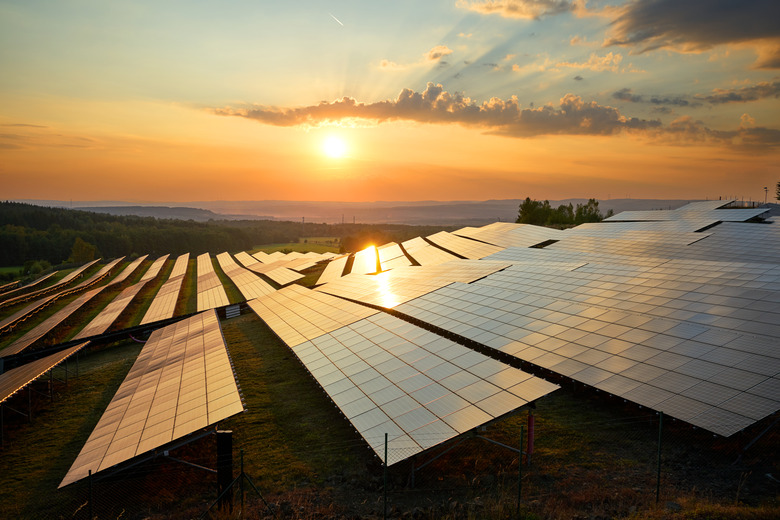Toxic Chemicals In Solar Panels
Solar panels may be an appealing choice for clean energy, but they harbor their share of toxic chemicals. The toxic chemicals are a problem at the beginning of a solar panel's life — during its construction — and at the end of its life when it is disposed of. These two intervals are times when the toxic chemicals can enter into the environment.
The toxic chemicals in solar panels include cadmium telluride, copper indium selenide, cadmium gallium (di)selenide, copper indium gallium (di)selenide, hexafluoroethane, lead, and polyvinyl fluoride. Additionally, silicon tetrachloride, a byproduct of producing crystalline silicon, is highly toxic.
TL;DR (Too Long; Didn't Read)
During manufacture and after the disposal of solar panels, they release hazardous chemicals including cadmium compounds, silicon tetrachloride, hexafluoroethane and lead.
Cadmium Telluride
Cadmium Telluride
Cadmium telluride (CT) is a highly toxic chemical that is part of solar panels. In the journal, "Progress in Photovoltaics," it reported that male and female rats that received CT through ingestion did not gain weight as they normally should have. This lack of weight gain occurred at low, moderate and high doses. When inhaled, CT also prevented normal weight gain and caused lung inflammation and lung fibrosis, a hardening of lung tissue. From low to high doses of inhaled CT, the weight of the lungs increased. Moderate to high doses of inhaled CT proved lethal.
Copper Indium Selenide
Copper Indium Selenide
The study of rats in "Progress in Photovoltaics" showed that ingestion of moderate to high doses of copper indium selenide (CIS) prevented weight gain in females but not males. Moderate to high doses of inhaled CIS increased the weight of a rat's lungs and increased lung fibrosis. Lungs exposed to CIS produced high amounts of fluid. Another study of CIS on rats, reported in "Toxicology and Applied Pharmacology," revealed that inhaling CIS caused rats to develop abnormal growths in their lungs.
Cadmium Indium Gallium (Di)selenide
Cadmium Indium Gallium (Di)selenide
Cadmium indium gallium (di)selenide (CIGS) is another chemical in solar panels that is toxic to lungs. The "Journal of Occupational Health" reported a study in which rats received doses of CIGS injected into the airway. Rats received CIGS three times a week for one week, and then researchers examined lung tissue until three weeks after that. The scientists used a low, moderate and high dose of CIGS. All doses resulted in lungs that had spots that were inflamed, meaning they were damaged. Lungs also had spots that produced excessive fluid. These spots worsened as time went on after the one week of exposure.
Silicon Tetrachloride
Silicon Tetrachloride
One of the toxic chemicals involved with solar panels is not what's in the panels but is a byproduct of their production. Crystalline silicon is a key component of many solar panels. The production of crystalline silicon involves a byproduct called silicon tetrachloride. Silicon tetrachloride is highly toxic, killing plants and animals. Such environmental pollutants, which harm people, are a major problem for people in China and other countries. Those countries mass-produce "clean energy" solar panels but do not regulate how toxic waste is dumped into the environment. The country's inhabitants often pay the price.
References
- Stanford Magazine: The Possibility of a Solar-Powered Nation
- Toxicology and Applied Pharmacology: Comparative Pulmonary Absorption, Distribution, and Toxicity of Copper Gallium Diselenide, Copper Indium Diselenide, and Cadmium Telluride in Sprague–Dawley Rats
- Journal of Occupational Health: Subacute Pulmonary Toxicity of Copper Indium Gallium Diselenide Following Intratracheal Instillations into the Lungs of Rats.
- Washington Post: Solar Energy Firms Leave Waste Behind in China
Cite This Article
MLA
Ph.D., David H. Nguyen,. "Toxic Chemicals In Solar Panels" sciencing.com, https://www.sciencing.com/toxic-chemicals-solar-panels-18393/. 30 April 2018.
APA
Ph.D., David H. Nguyen,. (2018, April 30). Toxic Chemicals In Solar Panels. sciencing.com. Retrieved from https://www.sciencing.com/toxic-chemicals-solar-panels-18393/
Chicago
Ph.D., David H. Nguyen,. Toxic Chemicals In Solar Panels last modified March 24, 2022. https://www.sciencing.com/toxic-chemicals-solar-panels-18393/
